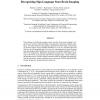Free Online Productivity Tools
i2Speak
i2Symbol
i2OCR
iTex2Img
iWeb2Print
iWeb2Shot
i2Type
iPdf2Split
iPdf2Merge
i2Bopomofo
i2Arabic
i2Style
i2Image
i2PDF
iLatex2Rtf
Sci2ools
ICPR
2010
IEEE
2010
IEEE
Recognizing Sign Language from Brain Imaging
The problem of classifying complex motor activities from brain imaging is relatively new territory within the fields of neuroscience and brain-computer interfaces. We report positive sign language classification results using a tournament of pairwise support vector machine classifiers for a set of 6 executed signs and also for a set of 6 imagined signs. For a set of 3 contrasted pairs of signs, executed sign and imagined sign classification accuracies were highly significant at 96.7% and 73.3% respectively. Multiclass classification results also were highly significant at 66.7% for executed sign and 50% for imagined sign. These results lay the groundwork for a brain-computer interface based on imagined sign language, with the potential to enable communication in the nearly 200,000 individuals that develop progressive muscular diseases each year.
Brain-computer Interface | Computer Vision | ICPR 2010 | Sign Language | Sign Language Classification |
| Added | 13 May 2010 |
| Updated | 13 May 2010 |
| Type | Conference |
| Year | 2010 |
| Where | ICPR |
| Authors | Nishant Mehta, Thad Starner, Melody Moore Jackson, Karolyn Babalola, George Andrew James |
Comments (0)

